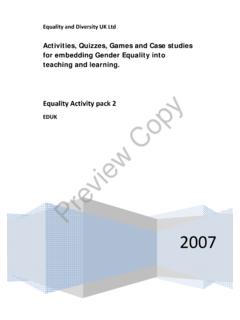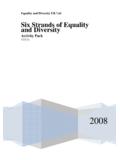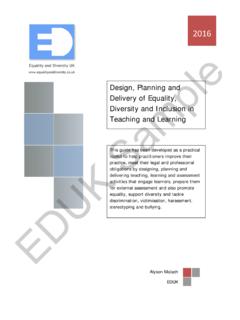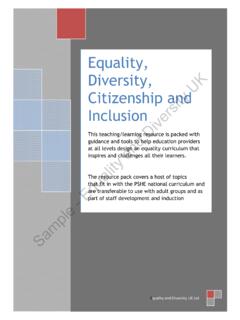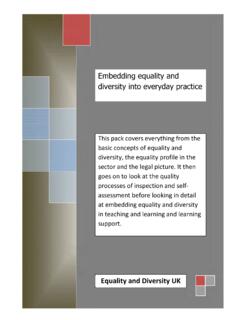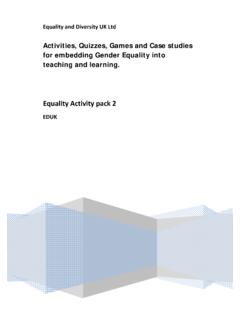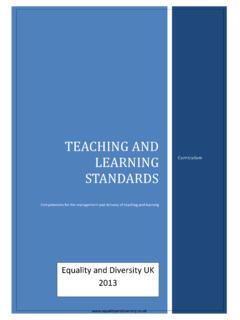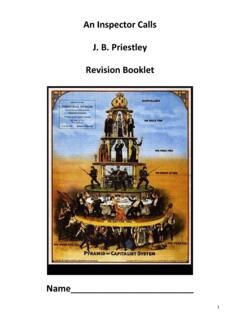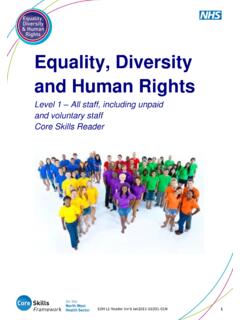Transcription of Managing DIversity and Inclusion
1 Managing DIversity AND Inclusion . A Practical Approach for the NHS. Busy NHS staff, managers, support staff and front-line workers need more than equality, DIversity and Inclusion awareness training. They need to be able to promote and foster equality and DIversity rather than just having good intentions to comply with the laws, and to respond professionally to DIversity . They need to be equipped with knowledge, skills and practical approaches to delivering on this agenda. Equality and DIversity UK. Contents About the resource 5. Context 5. About the pack 5. 1 Why is equality and DIversity important? 7. What do we mean by equality and DIversity ? 7. Equality 7. DIversity 7. Why is it important? 8. Equality and DIversity is a cornerstone of the NHS 8. The case for equality and DIversity 9. Equality and DIversity issues facing the NHS 10. Equality and DIversity in the NHS workforce 10. Health inequalities 13. 2 What does the law say? 15. Who does the law protect? 15. Protected characteristics 15.
2 What sort of discrimination is unlawful? 16. Types of discrimination 16. The organisation as an employer: What the law prohibits at work 19. The organisation as a service: What the law prohibits in relation 20. to service users Lawful discrimination 21. 1. What else does a public body have to do? 22. How do NHS organisations ensure they comply with the law? 23. The NHS Equality and DIversity System (EDS2) 23. The knowledge and skills you need for your job 25. 3 What does it all mean for you? 28. The importance of complying with the law 28. Employer liability 28. Personal liability 28. Your employer's responsibilities 28. Responsibilities towards employees 28. If things go wrong 29. Your personal responsibilities 30. General responsibilities 30. Additional responsibilities for those with specific roles 31. 4 Making yourself more equality and DIversity aware' 35. Recognising your own prejudices 35. We all have them 35. Overcoming them 35. Developing cultural and social awareness 36.
3 Differences in religious observance 36. Differences in dress 37. Differences in diet 38. Differences in body language 39. 2. 5 Good practice ideas to help you meet your 40. responsibilities Being more inclusive in what you say 40. The problems with language 40. Language related to age 40. Language related to disability 40. Language related to sexual orientation 42. Language related to gender 43. Language related to gender identity 43. Language related to race 44. Being more inclusive in what you do 44. Showing respect for DIversity 44. Everyday good practice 46. Challenging unacceptable behaviour 50. Actions you could take 50. Challenging using non-confrontational language 52. Planning your future contribution 53. Appendix: Further information 54. Resources 54. Legislation 54. Equality and DIversity in the NHS 56. Useful websites 57. 3. Activities 60. 1 The consequences of NOT embracing equality and DIversity 61. 2 Inequalities quiz 63. 3 Does the law protect them?
4 65. 4 Equality legislation quiz 68. 5 Equality and DIversity case studies 72. 6 How you contribute to EDS2 outcomes 80. 7 Familiarising yourself with your equality and DIversity 84. responsibilities 8 Raising your equality and DIversity awareness 91. 9 Is this an acceptable term? 94. 10 Encouraging respect for DIversity 97. 11 Get better at challenging unacceptable behaviour 100. 12 Challenging in a non-confrontational way 102. 13 Equality and DIversity personal health check 104. 4. About the resource Context Equality and DIversity are fundamental principles that underpin much of what the NHS is tasked to do. The NHS Constitution 2012 has equality at its heart, requiring National Health Service organisations to provide a comprehensive service, available to all irrespective of gender, race, disability, age, sexual orientation, religion or belief, gender reassignment, pregnancy or maternity or marital or civil partnership status. In order to achieve this, the NHS aims to attract, retain and develop the best talent from all sections of the communities it serves.
5 The NHS Knowledge and Skills Framework (NHS KSF) defines and describes the knowledge and skills that staff need to apply in their work to deliver quality services. Every post to which the KSF. applies must contain the six core dimensions at the correct level for the role. Core Dimension 6 is equality and DIversity . This resource aims to helps NHS staff to turn these guiding principles into tangible action. About the pack This pack provides an induction and refresher package for staff working in a range of capacities in healthcare settings. It can be used to form the basis either of formal induction training or guided self study for new and existing staff, including temporary staff, volunteers and people on work placement. In addition, it can be used flexibly to support delivery of equality and DIversity training sessions for those working directly with patients, their carers and families, members of the public, volunteers or staff. The pack has been developed as a practical toolkit to help staff meet their legal and professional obligations and follow a twin-track approach to equality and DIversity : that of tackling inequalities and fostering good relations between different groups.
6 It aims to: remove any mystery and misconceptions and clearly explain the concepts of equality, DIversity , Inclusion and discrimination 5. suggest simple strategies for supporting equality and DIversity in everyday situations that staff at all levels can put into practice straight away offer practical advice on dealing with challenging situations in an effective way demonstrate how embracing equality and DIversity creates a better working and healthcare environment for everyone improve understanding and social awareness of why people behave differently and thus reduce the incidence of unwitting and unintentional discriminatory behaviour in the workplace and healthcare settings. The information in the pack is supplemented by a range of activities to help you test your understanding and apply your learning to your own situation. Many of the activities will kick start the preliminary thinking, planning and awareness raising processes you will need to embed equality and DIversity into your area of work.
7 The following icons help to guide you around the pack. Signposts you to Signposts you to an another section of activity to help you the pack where you develop skills or plan can find out more on your next move for the topic promoting equality and DIversity Signposts you to the Further information appendix for ideas on where to find out more about the topic 6. 1 Why is equality and DIversity important? What do we mean by equality and DIversity ? Equality Equality does not mean treating everyone in the same way. It is about recognising that everybody is different, yet treating everyone with an equal level of respect and ensuring they have an equal opportunity to access and benefit from things like healthcare services. It involves removing the barriers which prevent some people from getting as much from these things as everyone else. Equality is about: treating people with dignity, respect and fairness ensuring that bullying, harassment, unfair discrimination and unacceptable behaviour are not tolerated providing a working and healthcare culture that includes everyone and encourages and enables people to achieve their potential delivering a healthcare service with equality of access, equality of impact and equality of outcome for all.
8 DIversity DIversity takes things a step further. It is about recognising, respecting, valuing and drawing on the positive aspects of differences not just the more obvious ones of gender, ethnicity, disability and age, but also the less visible differences such as background, beliefs, sexual orientation, personality and learning or work style. DIversity fosters an environment that recognises the contribution each person makes or can make. It promotes dignity and respect. Embracing DIversity offers a winning strategy it benefits the organisation, colleagues, the community, people who use or may need to use the service and the individual. In the past we have assumed the golden rule' for interacting with people successfully to be Treat others in the way you would like to be treated'. This assumes that all people are the same like you. By embracing DIversity we should now aspire to a platinum rule' whereby we Treat others in the way they would like to be treated'. 7. 2 What does the law say?
9 Who does the law protect? The Equality Act 2010 drew together, simplified, strengthened and replaced the 116. different acts of parliament, regulations, codes of practice and guidance which previously expressed similar concepts in different words and applied different tests to what might be thought of as similar situations. Protected characteristics The law identifies nine protected characteristics, previously known as equality strands' or grounds' for discrimination. Characteristic This protects: Age People of a particular age or in a particular age range People with a physical or mental impairment which has a substantial and long-term adverse effect on their ability to carry Disability out normal day-to-day activities or, from the time it is diagnosed, people with HIV/AIDS, multiple sclerosis or cancer Gender People undergoing the process of transitioning from one gender reassignment to another Marriage and Couples who are registered as married or in a civil partnership civil (same sex).
10 Partnership Women who are expecting a baby (pregnant) or on maternity Pregnancy leave (in the context of employment) or 26 weeks after giving and maternity birth (in a non-work context), and includes unfavourable treatment because a woman is breastfeeding People of any race, colour, nationality (including citizenship), Race ethnic or national origin Religion or People of any religion or religious or philosophical belief that belief affects their life choices or the way they live, or lack of belief Sex Men and women Sexual People whose sexual attraction is towards their own sex, the orientation opposite sex or to both sexes 15. 3 What does it all mean for you? The importance of complying with the law If you break the law in the course of your work there can be serious consequences both for your employer and for you. Employer liability Organisations, as employers, are liable for an act of an employee which is done in the course of employment', even if the employer did not know about it or approve of it.
